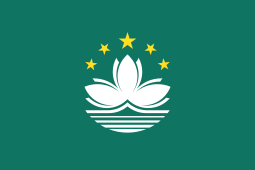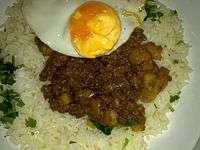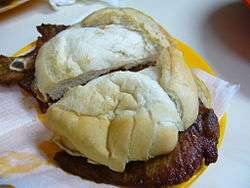Macanese cuisine
Macau cuisine (Chinese: 澳門菜, Portuguese: culinária de Macau) consists of a mosaic of Cantonese and Portuguese cuisines, and fusion cuisine with significant influences from Southeast Asia and the Lusophone world. Although many routinely consumed dishes in Macau belong to a subclass (Heungshan) of Cantonese cuisine, a reowned distinct cuisine called Macanese cuisine (Chinese: 澳門土生葡菜 Macau native-born Portuguese cuisine; Portuguese: gastronomia Macaense; Chinese: 土生葡人美食烹飪技藝 native-born Portuguese dishes cooking artistry) is unique to Macau. Many unique Macanese dishes resulted from the spice blends that the wives of Portuguese sailors used in an attempt to replicate European dishes. Besides local Chinese ingredients, ingredients and seasonings of Macanese dishes also include those from Europe, Latin America, Africa, India and Southeast Asia. Genuine Portuguese and Spanish cuisine can also be found in Macau.
| Part of a series on the |
| Culture of Macau |
|---|
 |
| History |
|
People |
| Languages |
| Cuisine |
|
Festivals |
| Religion |
|
Music and performing arts |
|
Media
|
| Sport |
|
Symbols
|
Common cooking techniques include baking, grilling and roasting. The former, seldom seen in other styles of Chinese cooking, exemplifies the eclectic nature of Macanese cooking. Macau is renowned for its flavour-blending culture, and modern Macanese cuisine may be considered a type of fusion cuisine.
Typically, Macanese food is seasoned with various spices including turmeric, coconut milk, and cinnamon, and dried cod (bacalhau), giving special aromas and tastes. Famous dishes include galinha à Portuguesa, galinha à Africana (African chicken), bacalhau (traditional Portuguese salt cod),[1] pato de cabidela, Macanese chili shrimps, minchi,[2][3][4] and stir-fried curry crab. Other dishes include pig's ear and papaya salad, and rabbit stewed in wine, cinnamon and star anise. Tapas are also an integral part of Macanese cuisine.
The most popular dessert is pastéis de nata (egg tarts). The most popular desserts/snacks like ginger milk, pork chop bun, and almond cake are generally considered Macau cuisine rather than Macanese cuisine because they are either originated from Zhongshan and Zhuhai or considered not exotic/Portuguese enough.
Famous restaurants of Macau include the Restaurante Riqueixo, Porto Interior, Restaurante Litoral, Restaurante Espao and Restaurante O Santos.
Macanese dishes and desserts
- Pastéis de nata
- Pato de cabidela

Some non-Macanese Macau snacks
 Pork chop bun
Pork chop bun- Apricot kernel biscuit
 The Macau ginger milk curd resembles this Hong Kong ginger milk curd.
The Macau ginger milk curd resembles this Hong Kong ginger milk curd.
Select bibliography
- Ferreira Lamas, João António (1995). A culinária dos macaenses. Oporto: Lello & Irmão.
- Gomes, Maria Margarida (1984). A cozinha macaense. Macau: Imprensa Nacional.
- Senna, Maria Celestina de Mello e (1998). Cozinha de Macau. Lisbon: Vega ISBN 972-699-575-2
References
- SILVA, A. J. M. (2015), The fable of the cod and the promised sea. About portuguese traditions of bacalhau, in BARATA, F. T- and ROCHA, J. M. (eds.), Heritages and Memories from the Sea, Proceedings of the 1st International Conference of the UNESCO Chair in Intangible Heritage and Traditional Know-How: Linking Heritage, 14–16 January 2015. University of Evora, Évora, pp. 130-143. PDF version
- "Archived copy". Archived from the original on 2011-10-02. Retrieved 2010-06-22.CS1 maint: archived copy as title (link)
- "Archived copy" (PDF). Archived from the original (PDF) on 2010-05-29. Retrieved 2010-06-22.CS1 maint: archived copy as title (link)
- "Archived copy". Archived from the original on 2012-06-30. Retrieved 2010-06-22.CS1 maint: archived copy as title (link)